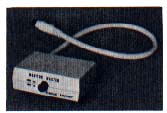ST Toolbox
Reviews:Monitor Master, Uninterruptible Power Supply

MONITOR MASTER
ST owners who use both color and monochrome monitors will recognize this ritual: Turn off monitor A, unplug its cable from the ST, connect the other cable, turn on monitor B and reboot the ST. The phrase "royal pain" seems to come to mind.
Enter the Monitor Master, a palm-sized plastic interface box. Both monitors plug into it and an output cable connects it to the ST video port. It draws its power from the monitors, so you don't need a separate power supply. A knob toggles between the two monitors.
Though switching monitors will make the ST reboot anyway--there's no other way for the ST to change resolution--there are a couple of public domain programs that ease the pain: Eternal, a RAMdisk that survives system reset and holds files while switching monitors; and Megaboot, which maintains separate DESKTOP.INF files for medium and hi-resolution, choosing the appropriat one for the monitor you're using.
If your ST has an RF modulator, Monitor Master can pull a composite video signal from a second video output and send it to a composite monitor or VCR. Connect it with a standard RCA phone jack cable. Another auxiliary output provides the monophonic audio-out from the monitors and can be hooked into your stereo system, greatly improving the sound quality for music programs games with sound effects.
The only problem is that if both monitors are turned on while close together, the screen image will shake slightly. The monitors are the cause, not the interface. You can put two feet or a thick metal barrier between the monitors, or simply turn off the one you're not using.
The bottom line is that if you use both monitors, you need the Monitor Master. I'd even suggest buying it solely for musical applications. It's much easier than installing an audio-out jack in your monitor, and it won't void your warranty.-- JlM PIERSON-PERRY
$49.99. Practical Solutions, Inc., 1930 East Grant Road, Tucson, AZ 85719. (602) 884-9612.
UNINTERRUPTIBLE POWER SUPPLY
Where I live, about every two months the power blinks out for a second or two. That's all it takes: my computer forgets its program and reboots; my VCR forgets its programming and blinks like a traffic light at 2 a.m. And you don't know misery till your wife finds out that her TV programs weren't recorded.
The solution is the Sendon Uninterruptible Power Supply (UPS). Just plug an appliance (typically your computer) into the UPS, then plug the UPS into a wall socket. While power is normal, it's business as usual, but when the power goes out, the UPS takes over from the line current and powers whatever is plugged into it. If the power is off for a while, the UPS gives you time to save your work and shut down your equipment.
The 300-watt UPS should power one monitor, the computer and floppies for about 15 minutes--plenty of time to save your work. You should not overload the UPS (by plugging in items requiring more than 300 watts--like a hair dryer). While the computer itself takes little power, the monitor and hard drive use a lot--remember a hard drive runs constantly, whether or not you're saving or loading anything.
The front panel has switches to turn the unit on and to activate the alarm mode. When the alarm mode is on, it beeps if the power fails. (This is sort of superflous, as you usually know when the power fails.) A red light on the front also indicates the level of battery charge. As the battery drains, the light flashes faster, until it stays on constantly and the battery is drained. The UPS has an automatic surge suppressor and noise attenuator, and it's also available in 400 watts with four plugs, and 500 watts with six plugs.--DAVID PLOTKIN
$239.95. Computer Parts Galore Inc., 56 Harvester Avenue, Batavia, NY 14020 (716) 343-6133.